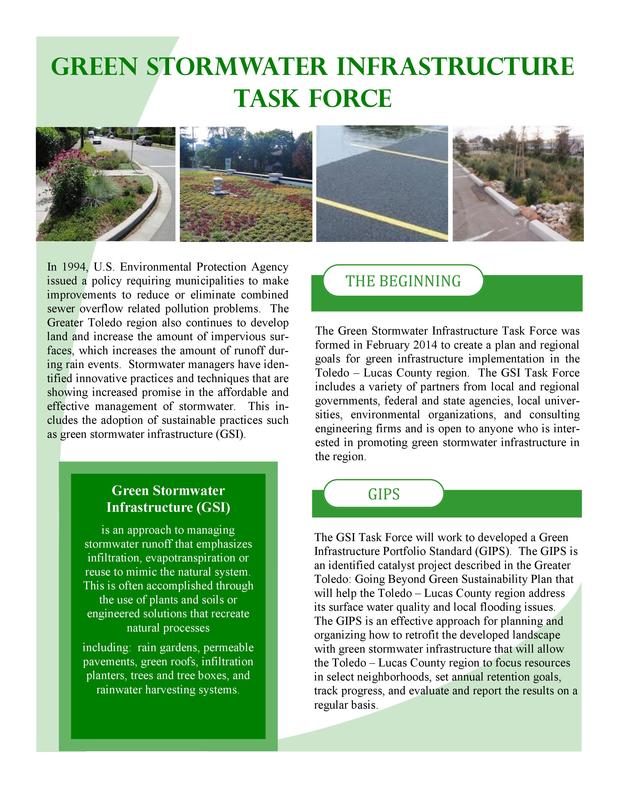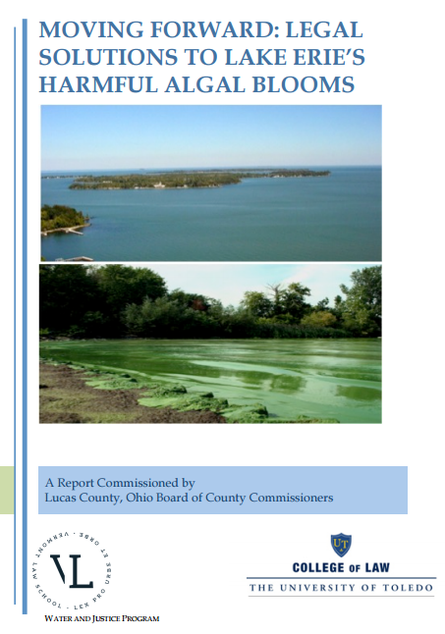TLCSC & Community Projects:
-
Nutrient Source Inventory
-
Green Infrastructure Task Force
-
Toledo Waterways Initiative
-
Clear Water 2
-
Moving Forward: HAB Solutions
<
>
Western Lake Erie
|
|
|
|
|
As Lucas County continues to develop, the increasing amount of impermeable surface areas contributes to rising volumes of runoff during rain events. One technique to curb the increased runoff is the adoption of sustainable practices such as green stormwater infrastructure (GSI). TLCSC in partnership with TMACOG and other organizations has created the Green Stormwater Infrastructure Task Force.
Learn more at: TMACOG Green Stormwater Infrastructure Webpage
Learn more at: TMACOG Green Stormwater Infrastructure Webpage
Since 2002 the Toledo Waterways Initiative (TWI) has been dedicated to managing and improving Toledo's rivers and streams. One such TWI project increased the wet weather capacity of the Bay View Water Reclamation Plant from roughly 200 million gallons per day to 400 million gallons per day. Since project completion in 2006, there have been no untreated overflows of sewage from the plant into the Maumee River. Before 2020, the City intends to plan, design, and implement dozens of projects that will address combined sewer overflows in the Maumee River, Ottawa River, and Swan Creek.
Learn more: toledowaterwaysinitiative.com
Learn more: toledowaterwaysinitiative.com
Clear Water 2 is an initiative sponsored by the Lucas County Commissioners partnering with the National Wildlife Federation (NWF) to communicate the seriousness of the pollution occurring in our waters and educates the public on water quality issues.
From The Blade's Featured Editorial on 7/9/15:
"In 1966, a group of local visionaries — including Toledo political leader Ned Skeldon, corporate executives Stephen Stranahan and Thomas Anderson, and Blade co-publisher Paul Block, Jr. — formed a nonprofit group, Clear Water Inc., to clean up the Lake Erie watershed. Clear Water’s advocacy, partnerships with other local institutions, and public education campaigns paid off.
The group’s leaders worked with state and federal officials to develop landmark antipollution legislation, including the federal Clean Water Act. They lobbied state officials to improve water management planning, set and enforce standards for drinking water quality, and provide financial aid to local communities to upgrade their sewage treatment plants. In 1973, Mr. Skeldon fulfilled his pledge to swim across the Maumee River at Walbridge Park, with no adverse effects. Five years later, Clear Water declared victory and went out of business. By the 1980s, Lake Erie’s phosphorus levels had been cut in half, and harmful algae blooms were under control.
...The new campaign has three main goals: to protect and manage watersheds in northwest Ohio more efficiently, to advance legal and policy solutions to address algae pollution in Lake Erie, and to assess how the need to battle toxic algae affects water rates for local consumers and businesses, with an eye to promoting regional cooperation on the issue.
Commissioner Tina Skeldon-Wozniak, Ned Skeldon’s daughter, told The Blade’s editorial page that Clear Water 2 will be a “grass-roots” effort that relies on public participation. “People are worried about health concerns” related to the condition of Lake Erie, she said. “We want to bring resources to the problem.”"
Check out this featured editorial and an additional article in The Blade for more information.
From The Blade's Featured Editorial on 7/9/15:
"In 1966, a group of local visionaries — including Toledo political leader Ned Skeldon, corporate executives Stephen Stranahan and Thomas Anderson, and Blade co-publisher Paul Block, Jr. — formed a nonprofit group, Clear Water Inc., to clean up the Lake Erie watershed. Clear Water’s advocacy, partnerships with other local institutions, and public education campaigns paid off.
The group’s leaders worked with state and federal officials to develop landmark antipollution legislation, including the federal Clean Water Act. They lobbied state officials to improve water management planning, set and enforce standards for drinking water quality, and provide financial aid to local communities to upgrade their sewage treatment plants. In 1973, Mr. Skeldon fulfilled his pledge to swim across the Maumee River at Walbridge Park, with no adverse effects. Five years later, Clear Water declared victory and went out of business. By the 1980s, Lake Erie’s phosphorus levels had been cut in half, and harmful algae blooms were under control.
...The new campaign has three main goals: to protect and manage watersheds in northwest Ohio more efficiently, to advance legal and policy solutions to address algae pollution in Lake Erie, and to assess how the need to battle toxic algae affects water rates for local consumers and businesses, with an eye to promoting regional cooperation on the issue.
Commissioner Tina Skeldon-Wozniak, Ned Skeldon’s daughter, told The Blade’s editorial page that Clear Water 2 will be a “grass-roots” effort that relies on public participation. “People are worried about health concerns” related to the condition of Lake Erie, she said. “We want to bring resources to the problem.”"
Check out this featured editorial and an additional article in The Blade for more information.
"Moving Forward: Legal Solutions to Lake Erie's Harmful Algal Blooms"
was commissioned by the Lucas County Commissioners in 2015 and is an in-depth analysis of the legal tools available to government leaders and policymakers to address water quality issues and examines the other regions that are grappling with similar challenges. As stated in the opening letter from the Commissioners:
"...The challenge of nutrient pollution is not new: in the 1960’s Lake Erie was infamously declared “dead.” Local, regional, federal, and international efforts to clean up Lake Erie ultimately led to the 1972 Federal Clean Water Act and the 1972 Great Lakes Water Quality Agreement, signed by the United States and Canada. Through public advocacy, jurisdictional cooperation, and broad stakeholder participation from governments, agriculture, industry, and the public, Lake Erie waters again were safe for drinking, recreation and as a habitat for abundant wildlife. But the lake is again under threat from nutrient pollution.
Moving Forward: Legal Solutions to Lake Erie’s Harmful Algal Blooms is an in-depth analysis of the legal tools available to address water quality issues, and examines how other regions are grappling with similar challenges. This report provides a framework for success in restoring and maintaining the health of Lake Erie. The 2014 Lake Erie Water Crisis is a call to action for all. We cleaned up Lake Erie once before; we can, and must, do it again."
View the report here.
was commissioned by the Lucas County Commissioners in 2015 and is an in-depth analysis of the legal tools available to government leaders and policymakers to address water quality issues and examines the other regions that are grappling with similar challenges. As stated in the opening letter from the Commissioners:
"...The challenge of nutrient pollution is not new: in the 1960’s Lake Erie was infamously declared “dead.” Local, regional, federal, and international efforts to clean up Lake Erie ultimately led to the 1972 Federal Clean Water Act and the 1972 Great Lakes Water Quality Agreement, signed by the United States and Canada. Through public advocacy, jurisdictional cooperation, and broad stakeholder participation from governments, agriculture, industry, and the public, Lake Erie waters again were safe for drinking, recreation and as a habitat for abundant wildlife. But the lake is again under threat from nutrient pollution.
Moving Forward: Legal Solutions to Lake Erie’s Harmful Algal Blooms is an in-depth analysis of the legal tools available to address water quality issues, and examines how other regions are grappling with similar challenges. This report provides a framework for success in restoring and maintaining the health of Lake Erie. The 2014 Lake Erie Water Crisis is a call to action for all. We cleaned up Lake Erie once before; we can, and must, do it again."
View the report here.




